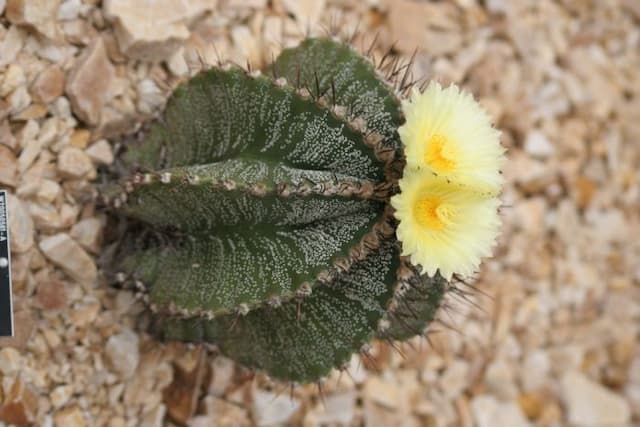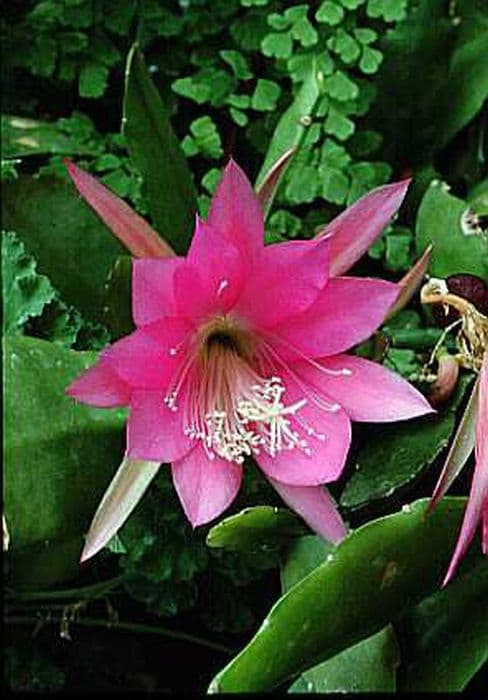Fishhook Barrel Cactus Ferocactus wislizenii

ABOUT
The common name for Ferocactus wislizenii is the Fishhook Barrel Cactus, which hints at one of its most distinguishing features: the curved, hook-like spines. The plant is a robust, barrel-shaped cactus that has a deep green color. The body of the cactus is ribbed, with numerous vertical lines running from the top to the bottom. These raised ribs help the cactus tolerate the sweltering sun they endure in their natural habitat by providing shade to the plant's own surface. What truly stands out on this cactus are its spines. They are usually reddish to yellow in color, and as mentioned, are curved and resemble fishhooks, which can snag onto passersby, clothing or animal fur. The fishhook quality of the spines is a primary identifier for this species. The cactus also blooms with stunning flowers. The flowers are typically vibrant, ranging from shades of yellow to orange and occasionally red, adding a pop of color against the stark green body. They are funnel-shaped and appear near the top of the cactus, often forming a crown-like circle. These flowers eventually produce round fruit that can be yellowish to red when mature, which contrasts beautifully with the green of the cactus and the reddish spines. Overall, the Fishhook Barrel Cactus is a hardy and characteristic plant with striking features that can be easily identified by its deep green flesh, pronounced ribs, fishhook spines, and brightly colored flowers and fruits.
About this plant
 Names
NamesSynonyms
Fishhook Barrel Cactus, Arizona Barrel Cactus, Candy Barrel Cactus, Southwestern Barrel Cactus, Biznaga de Aqua, Compass Barrel, Compass Cactus.
Common names
Echinocactus wislizeni, Ferocactus wislizeni, Ferocactus wislizenii subsp. wislizenii, Bisnaga wislizenii, Cactus wislizenii, Echinocactus palmeri, Echinocactus wislizenii.
 Toxicity
ToxicityTo humans
The plant commonly known as Fishhook Barrel Cactus is not considered toxic to humans. There are no significant toxins in this cactus that would lead to poisoning upon ingestion. Therefore, eating parts of this plant is unlikely to cause harmful effects beyond the potential physical injury from its spines.
To pets
The Fishhook Barrel Cactus is also not considered toxic to pets. It does not contain substances that are known to be poisonous to animals. However, the sharp spines can cause physical injury if a pet attempts to chew or swallow the plant, so it is wise to prevent pets from coming into contact with it to avoid injury.
 Characteristics
CharacteristicsLife cycle
Perennials
Foliage type
Evergreen
Color of leaves
Green
Flower color
Yellow
Height
6 feet (1.83 meters)
Spread
2 feet (0.61 meters)
Plant type
Cactus
Hardiness zones
9
Native area
Southwest USA
Benefits
 General Benefits
General Benefits- Decorative Appeal: The Fishhook Barrel Cactus features a unique spherical to cylindrical shape and striking hooked spines, making it popular in xeriscaping and desert-themed gardens.
- Drought Resistance: As a native desert species, it is highly tolerant to drought conditions, requiring minimal watering and maintenance.
- Wildlife Habitat: Provides shelter and food for desert fauna, such as birds and certain mammals which may use it for nesting or feeding on its flowers and fruit.
- Erosion Control: The robust root system helps stabilize soil and prevent erosion in arid landscapes.
- Heat Tolerance: It can withstand extremely high temperatures, making it suitable for hot climates where many other plants would struggle.
- Longevity: Can live for many years, providing a stable and lasting element in garden design.
- Educational Interest: Serves as an educational specimen for those interested in learning about desert flora and xerophytic adaptations.
 Medical Properties
Medical Properties- This plant is not used for medical purposes.
 Air-purifying Qualities
Air-purifying QualitiesThis plant is not specifically known for air purifying qualities.
 Other Uses
Other Uses- Traditional Native American food: The pulp of Fishhook Barrel Cactus is sometimes used as a cooking ingredient in traditional Native American cuisine.
- Livestock feed: In arid regions where the Fishhook Barrel Cactus grows, it can be used as emergency fodder for cattle during droughts when other vegetation is scarce.
- Fishhook replacement: The curved spines of the Fishhook Barrel Cactus have been historically used as fishhooks by Indigenous peoples.
- Temporary shelter material: In survival situations, the large ribs of the cactus can be used as material for constructing temporary shelters or sunshades.
- Water source: Though not ideal, in dire circumstances the cactus can be cut open to access water stored within its flesh to prevent dehydration.
- Boundary markers: Due to their size and distinct shape, these cacti can be used as natural boundary markers or to line pathways.
- Native landscaping: The Fishhook Barrel Cactus is often used in xeriscaping and drought-tolerant gardens for its low water requirements and aesthetic appeal.
- Pottery decoration: The spines and ribbed surface patterns can be used to create textures and patterns in traditional pottery.
- Companion planting: This cactus is sometimes planted alongside other crops as a means of providing shade and reducing soil erosion.
- Natural art medium: The Fishhook Barrel Cactus is used by some artists as a natural canvas, painting directly onto its surface.
Interesting Facts
 Feng Shui
Feng ShuiThe Fishhook Barrel Cactus is not used in Feng Shui practice.
 Zodiac Sign Compitability
Zodiac Sign CompitabilityThe Fishhook Barrel Cactus is not used in astrology practice.
 Plant Symbolism
Plant Symbolism- Resilience: The Fishhook Barrel Cactus, Ferocactus wislizenii, symbolizes resilience due to its ability to thrive in harsh, arid environments and withstand long periods without water.
- Protection: With its formidable spines, this cactus represents protection and defense, suggesting a barrier against negativity and adversity.
- Adaptation: Its efficiency in adapting to extreme conditions makes the Fishhook Barrel Cactus a symbol of adaptability and the ability to survive and flourish no matter the circumstances.
- Solitary Strength: Typically found standing alone, the Fishhook Barrel Cactus can embody solitary strength and the power of independence.
- Conservation: As a species native to the desert, it symbolizes the importance of conserving natural habitats and respecting the delicate balance of ecosystems.
 Water
WaterFor the Fishhook Barrel Cactus, it is essential to water sparingly as they are drought-tolerant plants. During the growing season in spring and summer, water the cactus every two to three weeks with about 8-10 ounces of water, providing enough to moisten the soil but allowing it to dry out completely between waterings. Reduce watering in fall and minimize it in winter to once a month or less, just enough to prevent the soil from becoming bone dry. It is crucial not to overwater as this can lead to root rot and other issues.
 Light
LightThe Fishhook Barrel Cactus thrives in full sunlight conditions. It is best placed in a spot where it can receive at least six hours of direct sunlight daily. An ideal location would be a south-facing window or a sunny outdoor area that is shielded from extreme midday heat during the hottest months. However, young plants may need some light shade to prevent sunburn.
 Temperature
TemperatureThe Fishhook Barrel Cactus prefers warm temperatures ranging from 70°F to 100°F during its active growth period. It can tolerate temperatures as low as 25°F for short periods but should be protected from frost. The plant's ideal temperature range is between 70°F and 80°F for optimal growth and flowering.
 Pruning
PruningPruning of the Fishhook Barrel Cactus is generally not necessary as it maintains a natural, spherical or columnar shape. If any damaged or dead spines or sections occur, they can be carefully removed using tongs or gloves. Pruning, if needed, should be done in the spring or early summer to allow any wounds to heal quickly.
 Cleaning
CleaningNot needed
 Soil
SoilThe best soil mix for the Fishhook Barrel Cactus (Ferocactus wislizenii) is a well-draining cactus mix with added perlite or pumice. The soil pH should be slightly acidic to neutral, ranging from 6.0 to 7.5.
 Repotting
RepottingFishhook Barrel Cacti should be repotted every three to four years to refresh the soil and accommodate growth. Younger plants may be repotted more frequently, about every two years, until they reach maturity.
 Humidity & Misting
Humidity & MistingFishhook Barrel Cactus thrives in low humidity conditions, typical of its native desert environment. The best humidity level for this plant is between 10% and 30%.
 Suitable locations
Suitable locationsIndoor
Place in bright light, minimal water, well-draining soil.
Outdoor
Full sun, little water, protect from extreme cold.
Hardiness zone
9-11 USDA
 Life cycle
Life cycleThe common name for Ferocactus wislizenii is the Fishhook Barrel Cactus. It begins as a seed, usually dispersed by animals or runoff, that germinates in the favorable conditions of warm temperatures and moisture. During its seedling stage, the cactus is small and vulnerable, growing slowly as it develops its root system. As it matures into the juvenile phase, it forms a recognizable barrel shape and its distinctive hooked spines, using water stored in its tissues to survive droughts. The mature Fishhook Barrel Cactus may produce vibrant flowers and fruit during the rainy season, which are pollinated by insects, birds, and bats. Finally, as an adult, it can live for decades, reaching heights of up to 10 feet, and only collapses and dies after a long period of resource storage and reproduction, completing its life cycle.
 Propogation
PropogationPropogation time
Spring-Early Summer
The Fishhook Barrel Cactus (Ferocactus wislizenii) is most commonly propagated through seeds since they do not typically produce offsets like some other cacti. The ideal time for sowing seeds is late spring to early summer when temperatures are consistently warm, which is conducive to germination. To propagate by seeds, one should prepare a well-draining cactus potting mix and sprinkle the seeds over the surface, followed by a thin layer of sand or fine gravel to anchor them in place. The planting medium should be kept moist but not waterlogged, and placed in a warm, bright location without direct sunlight to avoid scorching the delicate seedlings. Germination can take anywhere from a few weeks to several months, and once the seedlings have grown enough to handle, they can be gently transplanted into individual pots to continue their growth.









